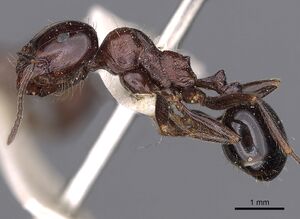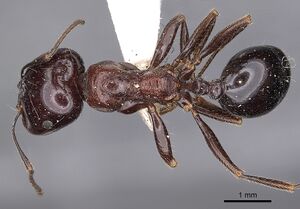Messor dentatus
| Messor dentatus | |
|---|---|

| |
| Scientific classification | |
| Kingdom: | Animalia |
| Phylum: | Arthropoda |
| Class: | Insecta |
| Order: | Hymenoptera |
| Family: | Formicidae |
| Subfamily: | Myrmicinae |
| Tribe: | Stenammini |
| Genus: | Messor |
| Species group: | instabilis |
| Species complex: | wasmanni |
| Species: | M. dentatus |
| Binomial name | |
| Messor dentatus Santschi, 1927 | |
Pashaei Rad et al. (2018) found this species in Iran on the ground in a dry to very dry farmland area.
Identification
Distribution
Latitudinal Distribution Pattern
Latitudinal Range: 36.77° to 31.766667°.
| North Temperate |
North Subtropical |
Tropical | South Subtropical |
South Temperate |
- Source: AntMaps
Distribution based on Regional Taxon Lists
Palaearctic Region: Iran, Israel (type locality), Türkiye.
Distribution based on AntMaps
Distribution based on AntWeb specimens
Check data from AntWeb
Countries Occupied
| Number of countries occupied by this species based on AntWiki Regional Taxon Lists. In general, fewer countries occupied indicates a narrower range, while more countries indicates a more widespread species. |

|
Estimated Abundance
| Relative abundance based on number of AntMaps records per species (this species within the purple bar). Fewer records (to the left) indicates a less abundant/encountered species while more records (to the right) indicates more abundant/encountered species. |

|
Biology
Castes
Images from AntWeb
   
| |
| Syntype of Messor semirufus nigriceps. Worker. Specimen code casent0900483. Photographer Ryan Perry, uploaded by California Academy of Sciences. | Owned by NHMUK, London, UK. |
   
| |
| Syntype of Messor dentatus. Worker. Specimen code casent0907733. Photographer Will Ericson, uploaded by California Academy of Sciences. | Owned by MHNG, Geneva, Switzerland. |
Nomenclature
The following information is derived from Barry Bolton's Online Catalogue of the Ants of the World.
- dentatus. Messor semirufus var. dentatus Santschi, 1927c: 228.
- Type-material: syntype workers, syntype queens, syntype males (numbers not stated).
- Type-locality: Israel: Jerusalem (E. Schmitz).
- Type-depository: MHNG.
- [First available use of Messor barbarus subsp. semirufus var. dentata Forel, 1910a: 10 (w.q.m.) ISRAEL; unavailable (infrasubspecific) name.]
- Menozzi, 1933b: 54 (q.).
- As unavailable (infrasubspecific) name: Forel, 1911d: 346; Emery, 1921f: 72; Emery, 1922c: 97.
- Subspecies of semirufus: Menozzi, 1933b: 53; Aktaç, 1977: 120.
- Junior synonym of semirufus: Baroni Urbani, 1974: 227.
- Status as species: Tohmé, G. & Tohmé, H. 1981: 143; Agosti & Collingwood, 1987a: 54; Agosti & Collingwood, 1987b: 271 (in key); Kugler, J. 1988: 257; Bolton, 1995b: 253; Petrov, 2006: 92 (in key); Paknia, et al. 2008: 154; Vonshak, et al. 2009: 42; Kiran & Karaman, 2012: 19; Borowiec, L. 2014: 104; Tohmé, G. & Tohmé, 2014: 134; Borowiec, L. & Salata, 2020: 10.
- Distribution: Iran, Israel, Jordan, Lebanon, Syria, Turkey.
Description
References
- Baroni Urbani, C. 1974a. Studi sulla mirmecofauna d'Italia. XII. Le Isole Pontine. Fragm. Entomol. 9: 225-252 (page 227, Junior synonym of semirufus)
- Borowiec, L. 2014. Catalogue of ants of Europe, the Mediterranean Basin and adjacent regions (Hymenoptera: Formicidae). Genus (Wroclaw) 25(1-2): 1-340.
- Borowiec, L., Salata, S. 2020. Review of ants (Hymenoptera: Formicidae) from Jordan. Annals of the Upper Silesian Museum in Bytom, Entomology 29 (online 2): 1-26 (doi:10.5281/zenodo.3733156).
- Forel, A. 1910a. Glanures myrmécologiques. Ann. Soc. Entomol. Belg. 54: 6-32 (page 10, First available use of Messor barbarus subsp. semirufus var. dentata; unavailable name.)
- Kiran, K., Karaman, C. 2020. Additions to the ant fauna of Turkey (Hymenoptera, Formicidae). Zoosystema 42(18), 285-329 (doi:10.5252/zoosystema2020v42a18).
- Pashaei Rad, S., Taylor, B., Torabi, R., Aram, E., Abolfathi, G., Afshari, R., Borjali, F., Ghatei, M., Hediary, F., Jazini, F., Heidary Kiah, V., Mahmoudi, Z., Safariyan, F., Seiri, M. 2018. Further records of ants (Hymenoptera: Formicidae) from Iran. Zoology in the Middle East 64, 145-159 (doi:10.1080/09397140.2018.1442301).
- Salata, S., Lapeva-Gjonova, A., Georgiadis, C., Borowiec, L. 2023. Review of the Messor semirufus complex (Hymenoptera, Formicidae) in Greece. ZooKeys 1185, 105–142 (doi:10.3897/zookeys.1185.111484).
- Santschi, F. 1927d. Revision des Messor du groupe instabilis Sm. (Hymenopt.). Bol. R. Soc. Esp. Hist. Nat. 27: 225-250 (page 228, worker, queen, male described)
- Tohmé, G.; Tohmé, H. 1981. Les fourmis du genre Messor en Syrie. Position systématique. Description de quelques ailés et de formes nouvelles. Répartition géographique. Ecol. Mediterr. 7(1 1: 139-153 (page 143, Revived from synonymy, and raised to species)
References based on Global Ant Biodiversity Informatics
- Aktaç, N.. "Studies on the myrmecofauna of Turkey I. Ants of Siirt, Bodrum and Trabzon." Istanbul Universitesi Fen Fakultesi Mecmuasi. Seri B 41 (1977): 115-135.
- Borowiec L. 2014. Catalogue of ants of Europe, the Mediterranean Basin and adjacent regions (Hymenoptera: Formicidae). Genus (Wroclaw) 25(1-2): 1-340.
- Forel A. 1910. Glanures myrmécologiques. Ann. Soc. Entomol. Belg. 54: 6-32.
- Forel A. 1911. Fourmis nouvelles ou intéressantes. Bull. Soc. Vaudoise Sci. Nat. 47: 331-400.
- Izhaki I., B. Idelovich, R. Laster, and Y. Ofer. 2009. The impact of macro- vs micro environmental factors on the structure of ant communities inhabiting East-Mediterranean Aleppo pine forests. Israel Journal of Entomology 39: 129-146.
- Kugler J. 1988. The zoogeography of Israel. 9. The zoogeography of social insects of Israel and Sinai. Monographiae biologicae 62: 251-275.
- Legakis Collection Database
- Paknia O., A. Radchenko, H. Alipanah, and M. Pfeiffer. 2008. A preliminary checklist of the ants (Hymenoptera: Formicidae) of Iran. Myrmecological News 11: 151-159.
- Pashaei Rad S., B. Taylor, R. Torabi, E. Aram, G. Abolfathi, R. Afshari, F. Borjali, M. Ghatei, F. Hediary, F. Jazini, V. Heidary Kiah, Z. Mahmoudi, F. Safariyan, and M. Seiri. 2018. Further records of ants (Hymenoptera: Formicidae) from Iran. Zoology in the Middle East 64(2): 145-159.
- Santschi, F.. "Revision des Messor du groupe instabilis Sm. (Hymenopt.)." Boletín de la Real Sociedad española de Historia natural (Madrid) 27 (1927): 225-250.
- Tohme G. 1996. Formicidae. Etude de la diversité biologique n° 4 . Ministère de lAgriculture à Beyrouth (Eds.). P85-87.
- Tohme G., and H. Tohme. 2014. Nouvelles liste des especes de fourmis du Liban (Hymenoptera, Formicoidea). Lebanese Science Journal 15(1): 133-141.
- Tohmé, G., and H. Tohmé. "Les fourmis du genre Messor en Syrie. Position systématique. Description de quelques ailés et de formes nouvelles. Répartition géographique." Ecologia Mediterranea 7 (1) (1981): 139-153, fig. 1-22.
- Vonshak M., and A. Ionescu-Hirsch. 2009. A checklist of the ants of Israel (Hymenoptera: Formicidae). Israel Journal of Entomology 39: 33-55.

